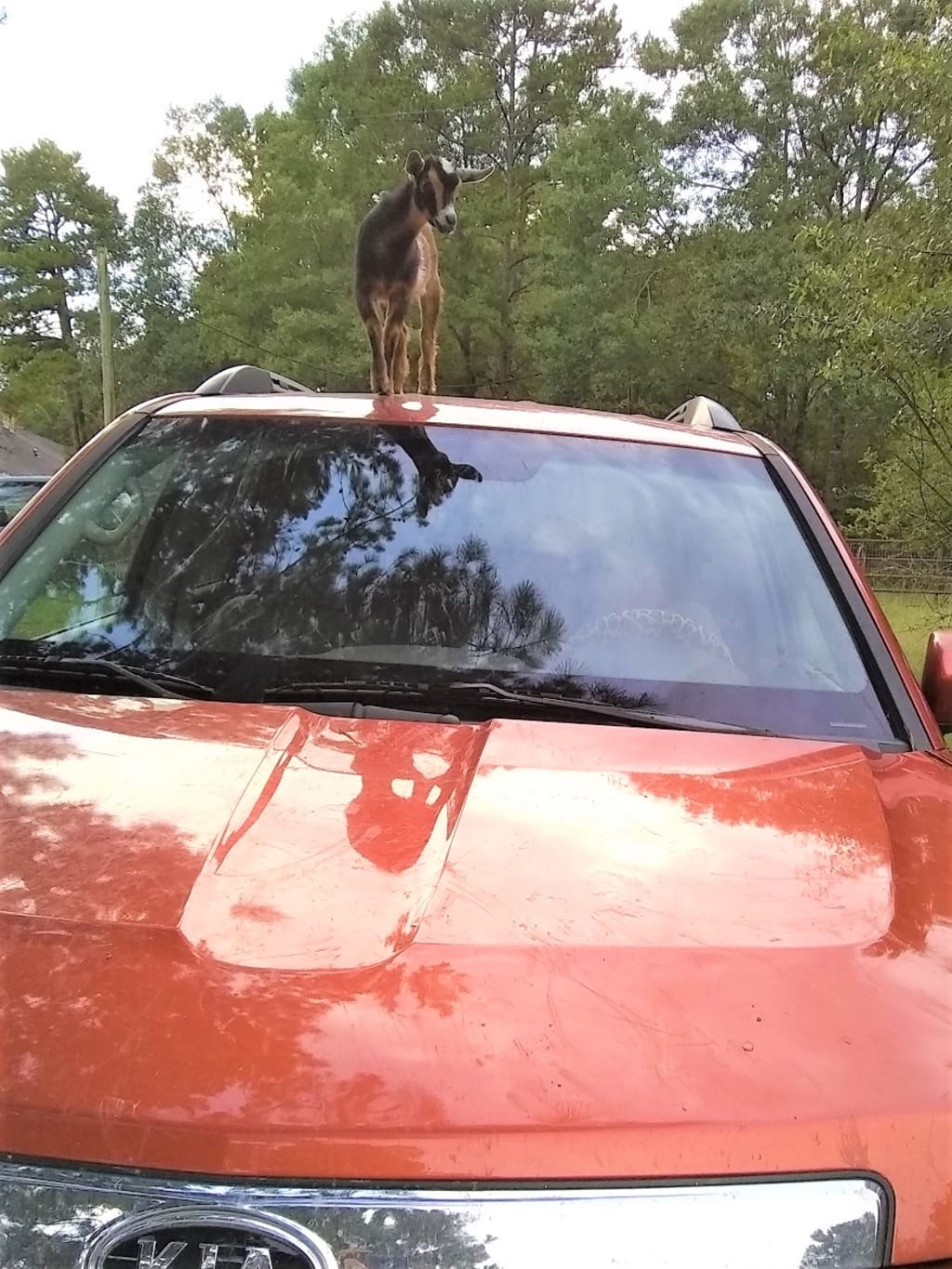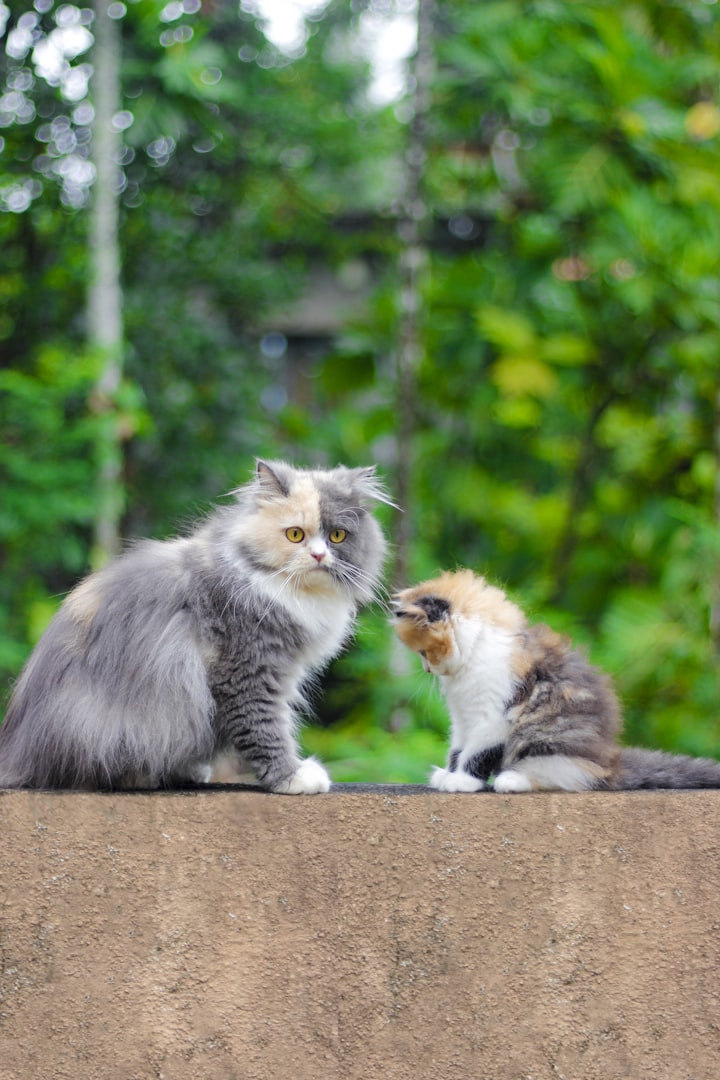
Every person who has goats both eagerly awaits and actively dreads kidding time. The "eagerly awaits" part is easy to understand. Kids are, as a rule, adorable. After their first week of life, they suddenly develop springs in their legs and the desire to jump on anything in their path. Just today, I found one of the kids on the apartment-sized refrigerator that is outside, waiting for Dan to haul it off for scrap metal. Why was he there? Not a clue. It's been sitting there since he was born, and he did not give it a glance. It is entirely possible that he simply waited until I needed a smile on my face. It's as good an explanation as any!
The "dreading it" part is comprised of many pieces, as individual as the goat herd. LaManchas--the breed of dairy goat that I own--are seasonal breeders. They come into heat between late July and late December/early January. They have a gestation period of 150 days, plus or minus 10. That means that kids are born anywhere from late December to late May. The weather during kidding season is humid and wet at best in this area, frozen and wet at worst. Very rarely does a doe like to give birth in the warm sun of day . . . no, they typically enjoy waiting until the middle of the night or in the throes of a storm. Mimi timed her 2021 kid just in time for "Snowmaggedon," when my area lost power for three days. For three days I endured freezing temperatures inside my house because there was a new kid on the ground, and it was not safe to walk Mimi up to Dan's. Neither could I drive the kid up because roads were impassable. Let's say it together: Thank you, Mimi!
Raven's Story
This year, I had two does giving birth. Raven, the new Nigerian Dwarf doe, was not supposed to be bred until later in the season. Raven, however, had other ideas. A little chocolate buckskin buckling with blue eyes and a super-tiny, black-based buckskin doeling with brown eyes. The buckling seemed to be stronger than the girl, who did not seem to want to nurse. I mixed some powdered goat colostrum with warm water and got out the PetAg bottle in an attempt to bottle feed her. She took well to the bottle, and I supplemented her for 24 hours. After 24 hours, she was doing better, but the buckling had stopped nursing. He did not do well with the bottle and rapidly failed, despite my best efforts to keep him hydrated.
The good news is that the doeling started nursing the day after her brother died and, only about 10 days after birth, started nibbling at grass and grain. This year, the tattoo letter for two major goat registries is "P," so I've been calling her "Princess Perky Pogo Stick" until I come up with a permanent name. Sadly, that name is starting to grow on me!

Mimi's Story
Mimi has given me some nice kids, two of which, sadly, passed on when they ate wilted cherry tree leaves. However, she's not been a terrific producer, partially reabsorbing three kids one year and failing to conceive another. Because she's no longer a young doe, I've decided that next year's kid is her last. She's a fun goat and can simply live out a retirement here, post breeding, even if she's not producing kids.
I went into this year's kidding without very high expectations for Mimi. Even though she was exposed to a buck starting in September, she did not seem to "settle" until almost November. Even when she stopped coming into heat, I wasn't entirely certain she was pregnant. I had started feeling life in her in February but could no longer feel it at the end of March. She did not seem to be very heavy, even as she reached day 145 after breeding. By the time she reached day 150 without delivering, I came to the conclusion that she had reabsorbed another pregnancy. Still, her hormones seemed to be working and she was "bagging up," so I was at least going to get milk from her.
Imagine my surprise when I came home a week later to find her in the end stages of labor! It was a good thing that I came home when I did, too, as she was straining heavily with a stuck kid! I'll spare you the details, but I managed to pull the kid's folded-back leg and get his head into position, so that he could slide easily from the birth canal. Mimi started cleaning her kid immediately and pawing at it to get it to its feet. At first, I had no idea what I was looking at. The kid was covered with dirt, of course, because Mimi could not wait to have me spread fresh straw or a blanket out for him. However, this kid appeared to be dark brown, marked with white. White markings are unsurprising, as Mimi is a "belted" goat," but she has consistently had black kids. Brown was not on the scorecard.
After the kid had dried off and been cleaned, I found out how far Mimi had strayed from her norm. Not only was her kid not black, but he was a black-based buckskin kid, heavily roaned, and his color so lightened that he appears almost solid white! Screechy, the sire is a light buckskin with an extended cape, so he appears dark, and Mimi is black. What a surprise! Unfortunately, this buckling's entry into life was not going to become much easier. Mimi has huge teats on her udder, so this little guy couldn't get his mouth around them. He did not like the bottle. He was not getting food or hydration, so I began to worry about my beautiful, unusual kid. I used a syringe to get some of Mimi's milk into him, to keep his strength up until he could figure out how to nurse. Every two hours, day and night, I was outside with him for a total of three days. Fortunately, this kid has a happy ending, too. Pale Rider is happily cavorting around the pasture and is now taking his first nibbles of grass and grain.

No, kidding season is not easy. Even when kidding goes without a hitch, there's often a lot of lost sleep waiting for kids to come or monitoring them for the first few days after birth. Is it worth it? Absolutely! The kids are fun to have around while they're here, if I sell them. It's also gratifying to see another generation of Mimis and Screechys and Ravens and Princess Perkys or Pale Riders come into existence. Are dairy goats for everyone? No! However, I could not imagine my life without them.
In this video, Raven, Pale Rider, and Princess Perky Pogo Stick graze quietly until Mimi comes into the frame. Patience the cat scratches in the background. Well done, ladies!
About the Creator
Kimberly J Egan
Welcome to LoupGarou/Conri Terriers and Not 1040 Farm! I try to write about what I know best: my dogs and my homestead. I currently have dogs, cats, dairy goats, quail, and chickens--and in 2025--rabbits! Come take a look into my life!






Comments
There are no comments for this story
Be the first to respond and start the conversation.